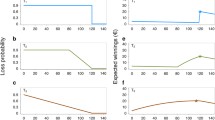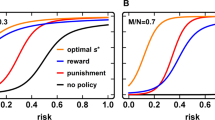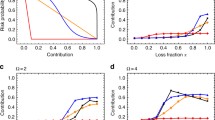Abstract
Given the lack of progress on climate change mitigation, some scientists have proposed solar geoengineering as a means to manage climate change at least temporarily. One main concern with such a risky technological solution, however, is that it may create a “moral hazard” problem by crowding out efforts to reduce emissions. We investigate the potential for a risky technological solution to crowd out mitigation with theory and experiments. In a collective-risk social dilemma, players strategically act to cooperate when there is an opportunity to deploy a risky technology to help protect themselves from impending damages. In contrast to the moral hazard conjecture, the empirical results suggest that the threat of solar geoengineering can lead to an increase in cooperative behavior.

Similar content being viewed by others
Data availability
Data and code are available via the Supplementary information.
Notes
The environmental risks associated with solar geoengineering include the potential for harmful effects to the ozone layer (Keith et al. 2016), greater ocean acidification (Williamson and Turley 2012), changes in global precipitation patterns (Irvine et al. 2019), and the long-term oscillations of natural climate systems (Gabriel and Robock 2015). See also the recent report by the National Academies of Science, Engineering and Medicine (NASEM, 2021).
In a recent article, David Keith (2021) summarizes the issue: “Perhaps the central concern about solar geoengineering is that deployment, or even the credible possibility of deployment, will slow emissions cuts. This concern—moral hazard, or mitigation inhibition—arises from political links between decisions about solar geoengineering and emissions cuts in the face of climate risks, […].” Lin (2013) is among the first papers that examine whether geoengineering presents a moral hazard and how to ameliorate this moral hazard.
We follow the literature and use the term “cooperation” to denote cooperative behavior that contributes (i.e., mitigation) to solving the collective action problem (i.e., climate change). Cooperative behavior may result from different motives, such as spite, self-interest, and altruism.
Note that another concern of geoengineering skeptics is that the risk of this technology is unevenly divided and falls mainly on poorer countries (Biermann et al. 2022). The focus of the current paper is on the impact of risk in general, so we assume homogeneity in downside risk. Related research (Cherry et al. 2022) considers that some countries are more (negatively) impacted by the deployment of solar geoengineering than others.
All supplemental information (SI), including theoretical model and predictions, additional analysis, data and code, and experimental instructions, is available on the Open Science Framework (OSF) at https://osf.io/ve9kw/?view_only=3862b1e218a346939d9dc30cfbf73bfb.
Potential losses decline proportionally as contributions approach the threshold, which corresponds to more mitigation leading to reduced potential damage from climate change.
This reflects the often-cited concern by geoengineering skeptics that “[g]iven the anticipated low monetary costs of some of these technologies, such as stratospheric aerosols injection, a few countries could engage in solar geoengineering unilaterally or in small coalitions even when other countries oppose such deployment” (Biermann 2022).
In our model and experiments, solar geoengineering is a binary choice and is either universally good or universally bad depending on the outcome from deploying the technology. This approach differs from other models and experiments that specify a distribution of “preferred” levels of solar geoengineering and continuous choices (e.g., Weitzman 2015; Abatayo et al. 2020; Cherry et al. 2022). Our simplified approach allows us to focus on the impact of potentially costly side effects on mitigation decisions. We vary risk by varying the probability of a bad outcome while holding the severity constant. Future research should consider varying the size of losses while holding the probability constant, as well as interacting probability and severity.
Given the ongoing debate about the potentially high risk of deploying solar geoengineering technologies (e.g., Biermann et al. 2022), we parameterized the experiment to investigate both extremes (\(\pi =0.1\) and \(\pi =0.9\)), a central value (\(\pi =0.5\)), and we explored one additional relatively high-risk option (\(\pi =0.3\)).
Outcomes from the random draw were not announced until the end of the session because studies show the realization of a random outcome, good or bad, in one round may have an impact on behavior in following rounds, even though round-specific payoffs are independent (e.g., Kroll and Shafran 2018).
References
Abatayo AL, Bosetti V, Casari M, Ghidoni R, Tavoni M (2020) Solar geoengineering may lead to excessive cooling and high strategic uncertainty. Proc Natl Acad Sci 117(24):13393–13398
Aldy J, Felgenhauer T, Pizer WA, Tavoni M, Belaia M, Borsuk ME, Ghosh A, Heutel G, Heyen D, Horton J, Keith D, Merk C, Cruz JM, Reynolds JL, Ricke K, Rickels W, Shayegh S, Smith W, Tilmes S, Wagner G, Wiener JB (2021) Social science research to inform solar geoengineering. Science 375(6569):815–818
Andrews TM, Delton AW, Kline R (2022) Anticipating moral hazard undermines climate mitigation in an experimental geoengineering game. Ecol Econ 196:107421
Austin MMK, Converse BA (2021) In search of search of weakened resolve: does climate-engineering awareness decrease individuals’ commitment to mitigation? J Environ Psychol 78:101690
Barrett S (2008) The incredible economics of geoengineering. Environ Resource Econ 39:45–54
Barrett S (2014) Solar geoengineering’s brave new world: thoughts on the governance of an unprecedented technology. Rev Environ Econ Policy 8(2):249–269
Biermann F, Oomen J, Gupta A, Ali SH, Conca K, Hajer MA, Kashwan P, Kotzé LJ, Leach M, Messner D, Okereke C, Persson A, Potocnik J, Schlosberg D, Scobie M, VanDeveer SD (2022) Solar geoengineering: the case for an international non-use agreement. WIREs Clim Chang 13(3):754. https://doi.org/10.1002/wcc.754
Brown TC, Kroll S (2017) Avoiding an uncertain catastrophe: climate change mitigation under risk and wealth heterogeneity. Clim Change 141:155–166
Cherry TL, Kroll S, McEvoy D, Campoverde D, Cruz JM (2022) Climate cooperation in the shadow of solar geoengineering: an experimental investigation of the moral hazard conjecture. Environ Polit. https://doi.org/10.1080/09644016.2022.2066285
Cherry TL, Kallbekken S, Kroll S, McEvoy DM (2021) “Does solar geoengineering crowd out climate change mitigation efforts? Evidence from a stated preference referendum on a carbon tax”. Climatic Change 165(6): https://doi.org/10.1007/s10584-021-03009-z.
Chhetri N, Chong D, Conca K, Falk R, Gillespie A, Gupta A, Jinnah S, Kashwan P, Lahsen M, Light A, McKinnon C, Thiele LP, Valdivia W, Wapner P, Morrow D, Turkaly C, Nicholson S (2018) Governing solar radiation management. Forum for Climate Engineering Assessment, American University, Washington, DC
Cox JC, Dinkin S, Swarthout JT (2001) Endogeneous entry and exit in common value auctions. Exp Econ 4:163–181
Dave C, Eckel CC, Johnson CA, Rojas C (2010) Eliciting risk preferences: when is simple better? J Risk Uncertain 41:219–243
Eckel C, Grossman P (2008) Forecasting risk attitudes: an experimental study using actual and forecast gamble choices. J Econ Behav Organ 68(1):1–17
Fairbrother M (2016) Geoengineering, moral hazard, and trust in climate science: evidence from a survey experiment in Britain. Clim Change 139(3–4):477–489
Falk A, Heckman JJ (2009) Lab experiments are a major source of knowledge in the social sciences. Science 326:535–538
Fischbacher U (2007) z-Tree: Zurich toolbox for ready-made economic experiments. Exp Econ 10(2):171–178
Gabriel CJ, Robock A (2015) Stratospheric geoengineering impacts on El Niño/Southern oscillation. Atmos Chem Phys 15(20):11949–11966
Greiner B (2015) Subject pool recruitment procedures: organizing experiments with ORSEE. J Econ Sci Assoc 1(1):114–125
Heutel G, Moreno-Cruz J, Shayegh S (2016) Climate tipping points and solar geoengineering. J Econ Behav Organ 132:19–45
Irvine P, Emanuel K, He J, Horowitz LW, Vecchi G, Keith D (2019) Halving warming with idealized solar geoengineering moderates key climate hazards. Nat Clim Chang 9:295–299
Jinnah S, Nicholson S, Morrow DR, Dove Z, Wapner P, Valdivia W, Thiele LP, McKinnon C, Light A, Lahsen M, Kashwan P, Gupta A, Gillespie A, Falk R, Conca K, Chong D, Chhetri N (2019) Governing climate engineering: a proposal for immediate governance of solar radiation management. Sustainability 11:3954
Keith DW (2021) Toward constructive disagreement about geoengineering. Science 374(6569):812–815
Keith DW, Weisenstein DK, Dykema JA, Keutsch FN (2016) Stratospheric solar geoengineering without ozone loss. Proc Natl Acad Sci 113(52):14910–14914
Kroll S, Shafran AP (2018) Spatial externalities and risk in interdependent security games. J Risk Uncertain 56(3):237–257
Lin AC (2013) Does geoengineering present a moral hazard? Ecol Law Quart 40:673–712
Merk C, Pönitzsch G, Rehdanz K (2016) Knowledge about aerosol injection does not reduce individual mitigation efforts. Environ Res Lett 11(5):1–6
Milinski M, Sommerfeld RD, Krambeck H-J, Reed FA, Marotzke J (2008) “The collective-risk social dilemma and the prevention of simulated dangerous climate change. Proc Natl Acad Sci 105:2291–2294
Millard-Ball A (2012) The Tuvalu syndrome. Clim Change 110(3):1047–1066
Moreno-Cruz JB (2015) Mitigation and the geoengineering threat. Resourc Energy Econ 41:248–263
National Academies of Sciences, Engineering, and Medicine (NASEM) (2021) Reflecting sunlight: recommendations for solar geoengineering research and research governance. The National Academies Press, Washington, DC. https://doi.org/10.17226/25762
Reynolds J (2019) The governance of solar geoengineering. Cambridge University Press, Cambridge
Snowberg E, Yariv L (2021) Testing the waters: behavior across participant pools. Am Econ Rev 111(2):687–719
Wagner G (2021) Geoengineering: the gamble. Polity Press
Wagner G, Zizzamia D (2022) Green moral hazards. Ethics, Policy Environ 25(3):264–280
Weitzman M (2015) A voting architecture for the governance of free-driver externalities. Scandinavian J Econ 117:1049–1068
Williamson P, Turley C (2012) Ocean acidification in a geoengineering context. Phil Trans R Soc A 370:4317–4342
Acknowledgements
We thank Mark Borsuk, Tyler Felgenhauer, Khara Grieger, Alex James, Jennifer Kuzma, Juan Moreno-Cruz, Billy Pizer, and Jonathan Wiener for valuable comments.
Funding
This material is based upon work supported by the National Science Foundation under Grant No. 2033855.
Author information
Authors and Affiliations
Contributions
All authors contributed to the conception and design, data analysis, and writing first, subsequent, and final drafts. All authors read and approved the final manuscript.
Corresponding author
Ethics declarations
Conflict of interest
The authors declare no competing interests.
Additional information
Publisher's Note
Springer Nature remains neutral with regard to jurisdictional claims in published maps and institutional affiliations.
Supplementary Information
Below is the link to the electronic supplementary material.
Rights and permissions
Springer Nature or its licensor (e.g. a society or other partner) holds exclusive rights to this article under a publishing agreement with the author(s) or other rightsholder(s); author self-archiving of the accepted manuscript version of this article is solely governed by the terms of such publishing agreement and applicable law.
About this article
Cite this article
Cherry, T.L., Kroll, S. & McEvoy, D.M. Climate cooperation with risky solar geoengineering. Climatic Change 176, 138 (2023). https://doi.org/10.1007/s10584-023-03612-2
Received:
Accepted:
Published:
DOI: https://doi.org/10.1007/s10584-023-03612-2




